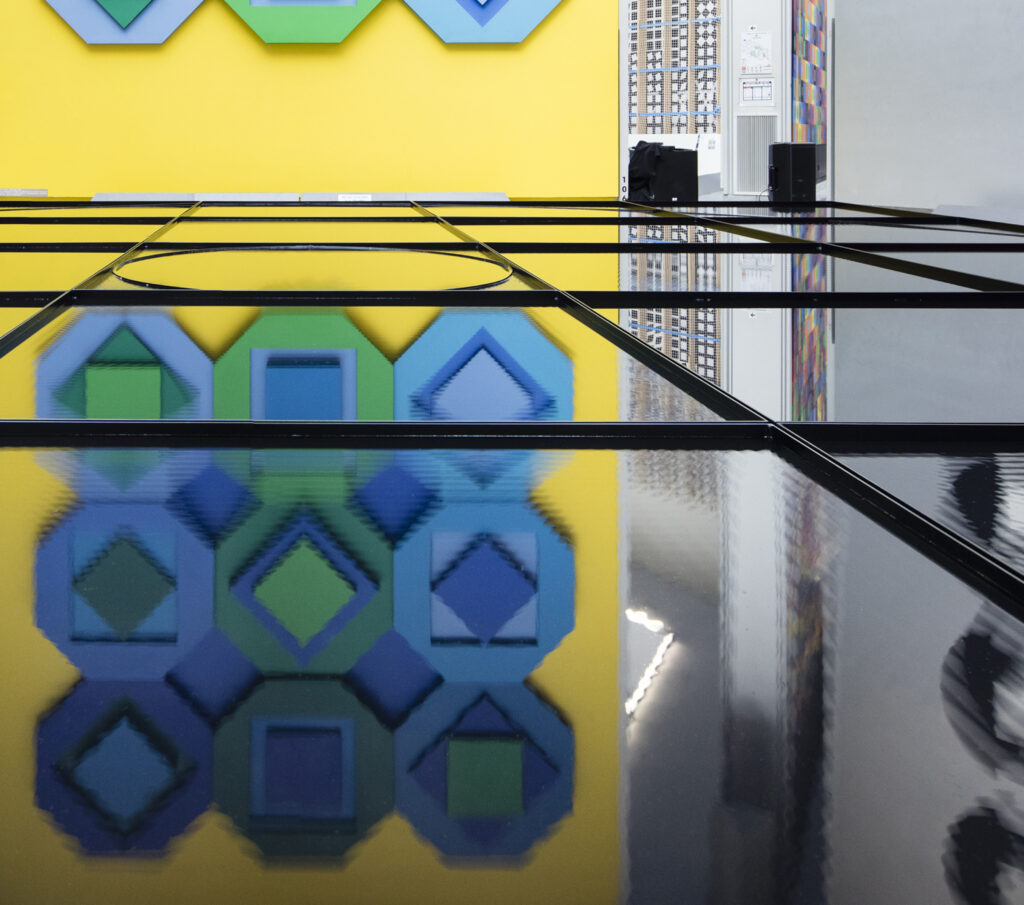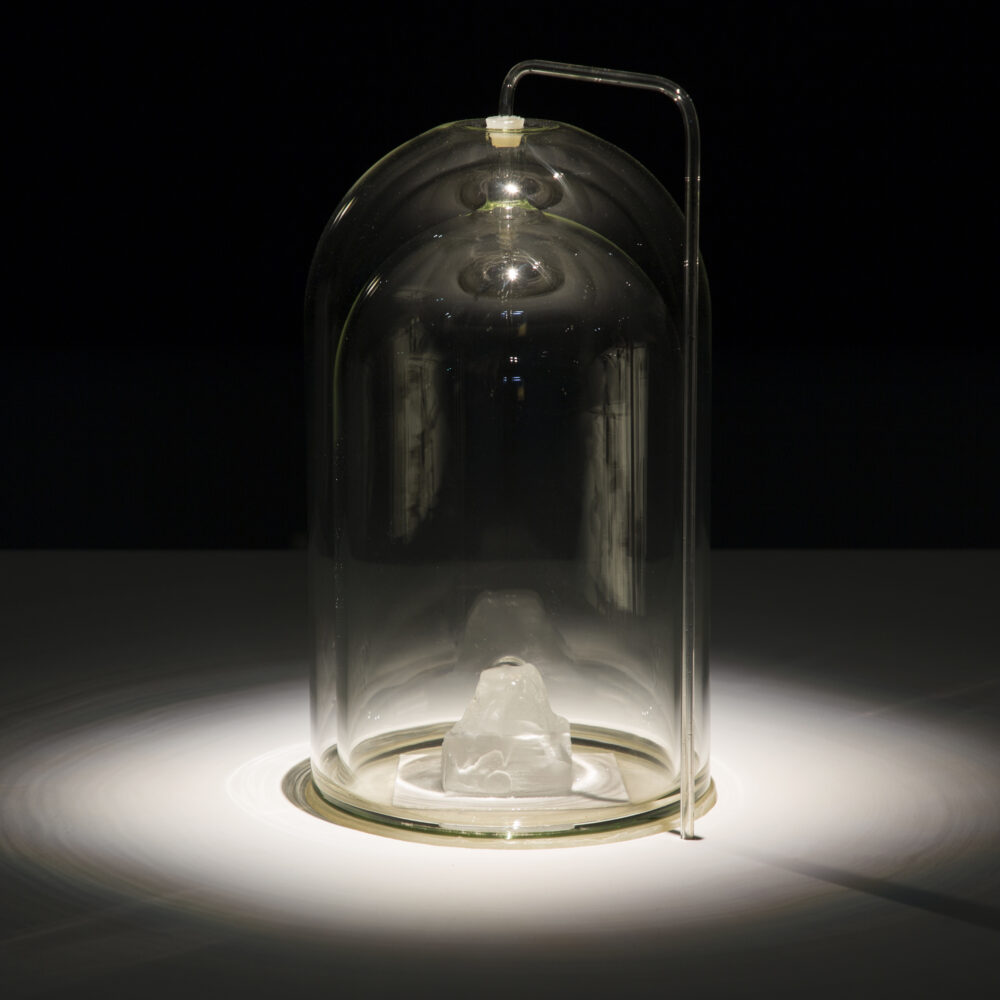kyil khor
FELICIE D’ESTIENNE D’ORVES, ACCOMPANIED BY A COMPOSITION OF ÉLIANE RADIGUE
Installation
Presented in room n°2 of the Vasarely Foundation, KYIL KHOR‘s water mirror and its kinetic ripples reflect Victor Vasarely’s vertical compositions.
This new project by Félicie d’Estienne d´Orves, winner of the Vasarely Foundation International Prize for Digital Arts in 2018, is the result of a collaboration with GANIL (National Grand Accelerator of Heavy Ions) in Caen. The work pays tribute to Victor Vasarely’s “Ondulatoires” series, produced in the 1950s, and to the artist’s research on the wave-particle duality of matter.
The artist explores the boundary between contemporary atomic physics and the ancient philosophy of Tibetan Buddhism. The work KYIL KHOR, literally meaning center or circle in Tibetan, is inspired by the pattern of the mandala. Traditionally made by Buddhist monks using colored sand, this cosmic diagram expresses the idea of the impermanence of reality and symbolizes a concentric structure of the universe.
The musical piece which accompanies the sculpture, Kailasha1, by experimental music pioneer Éliane Radigue, draws on the composer’s mental pilgrimage around Mount Kailash, a sacred Tibetan mountain.
KYIL KHOR‘s water mirror distorts and renews our vision of the surrounding environment. On the quantum scale, a particle doesn’t have a defined position and is characterized by a set of probabilities or wave functions. In the same way as atoms change shape at different energy levels, the matter of the water mirror rolls out the potential of its undulatory interferences in orderly chaos2.
1 From the Trilogy of Death [1998], “Kyema”, “Kailasha”, and “Koumé”
2 According to the Buddhist master Chögyam Trungpa, “Orderly Chaos: The Mandala Principle”, Point 2011

Share this event on social networks
Artists
Félicie d’Estienne d’Orves (FRA)
Born in Athens in 1979, Félicie d´Estienne d´Orves lives and works in Paris.
A plastic artist whose chosen material is light, her installations and performances call on a phenomenological knowledge of reality and question the conditioning of our vision. Light is both the tool and the subject of her work. She is interested in defining the physical and cosmological limits of space, through light and its speed.
Her work has been presented at the Centre Pompidou – Nuit Blanche – Le Centquatre 104 (Paris) – Le Fresnoy Scène Nationale (Tourcoing) – La Friche Belle de Mai (Marseille) – Cheminée EDF (Le Havre) – Abbaye de Maubuisson (Saint-Ouen-l’Aumône) – Watermans Arts Center (London) – New Art Space/Sonic Acts (Amsterdam) – TBA Teatro do Bairro Alto (Lisbon) – Ars Electronica (Linz) – Elektra Festival (Montreal) – Day For Night (Houston) – OCAT (Shanghai) – Aram Art Museum (Goyang/Korea)…
Éliane Radigue (FRA)
Éliane Radigue has been composing electronic music since the 1960s. She is considered to be one of the major pioneers of this musical genre, as well as of minimal music. Her music is a slow flow of dense sonorities undergoing imperceptible mutations. A timeless architecture made of bass vibrations, addressing the entire body rather than just the intellect or eardrums.
At the end of the fifties, she studied concrete music in Paris with Pierre Schaeffer and Pierre Henry, whose assistant she became, in particular for the making of “The Apocalypse of John”. During the sixties she started composing with primitive electronic means (feedback and asynchronous looped magnetic tapes), but found little recognition for her research in France. It was in New York that she found understanding and emulation in the early seventies, exploring the paths of nascent minimalism alongside James Tenney, Charlemagne Palestine, Philip Glass, Jon Gibson and Steve Reich.
She has since composed on the best synthesizers that have ever existed: Buchla, Moog, and Serge modular system, until Arp came to be her favorite instrument. She collaborated in the seventies with Robert Ashley, who lent her his voice for the songs of Milarepa. She has composed around twenty works so far. Since 2006 she has devoted her energy to composing for solo acoustic instruments, of which naldjorlak I, II, III, is the major culmination.
Credits & mentions
A work by Félicie d’Estienne d’Orves
Music : Éliane Radigue
Scientific consultants : Beyhan Bastin, Anthea Fantina, Françoise de Oliveira, Jean-Charles Thomas (GANIL)
Sound spatialization : Lionel Marchetti
Programming : Sylvain Garnavault, Thomas Pachoud
Modelisation: Sebastien Wierinck Workshop (SWWS)
Manufacturing: Atelier Delarasse, collectif Manœuvre
Technical manager : Thomas Leblanc, Emilie Fouilloux
Associate producer: Nicolas Wierinck (Archer & Weaver)
Production: Studio d’Estienne d’Orves, Station Mir / Festival ]interstice[
Creation produced in co-production with CHRONIQUES, the Biennale of Digital Imagination, coordinated by Seconde Nature and Zinc, the Vasarely Foundation and STEREOLUX / SCOPITONE.
With the support of Normandie Impressionniste, GANIL (National Grand Accelerator of Heavy Ions), the City of Caen and the City of Aix-en-Provence
With the participation of DICRéAM (Dispositif pour la Création Artistique Multimédia et Numérique)
Acknowledgments: Galerie Le Toit du Monde, Interface-Z, Oblique/s, HACNUM, ESAM
On the occasion of the presentation of the Prix International de la Fondation Vasarely – Biennale Chroniques 2018 to Félicie d’Estienne d’Orves, the Vasarely Foundation would like to thank its institutional partners: the DRAC-PACA, the South Region Provence Alpes-Côte-d’Azur, the Department of Bouches-du-Rhône, Aix-Marseille Metropolis – Pays d’Aix and the City of Aix-en-Provence as well as its private partners: Gécim, Marker and Hexalab.
Warning: Undefined variable $oeuvresLieesIds in /home/clients/6cd874e1a9c3606a339242af6d0db3da/sites/chroniques-biennale.org/wp-content/themes/biennale-2024/single-oeuvre.php on line 49


